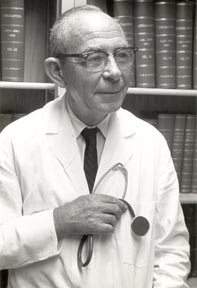 Tinsley Randolph Harrison was one of the most influential physicians of the 20th century. His worldwide fame rested primarily on his book Harrison's Principles of Internal Medicine, published in 1950 and reprinted 16 times and translated into 14 different languages. It remains the single-most-used and best-selling internal medicine text in the world.
Tinsley Randolph Harrison was one of the most influential physicians of the 20th century. His worldwide fame rested primarily on his book Harrison's Principles of Internal Medicine, published in 1950 and reprinted 16 times and translated into 14 different languages. It remains the single-most-used and best-selling internal medicine text in the world.
Dr. Harrison was born March 18, 1900, in Talladega, Alabama, and moved to Birmingham in 1906 with his parents, Dr. William Groce Harrison, a sixth-generation physician, and Louisa Marcia Bondurant Harrison. Completing public school in Birmingham at the age of 15, he spent a year at Marion Military Institute in Marion, Alabama, before enrolling at the University of Michigan, where he obtained a bachelor’s degree in 1919. Dr. Harrison then completed medical school at Johns Hopkins University in Baltimore and his internship and first-year residency in Boston at the Peter Bent Brigham Hospital in Boston, Massachusetts. He returned to Johns Hopkins for a year as assistant resident physician before moving to Nashville, Tennessee, in 1925 as the first chief resident physician for the new Vanderbilt Hospital and Medical School in Nashville.
He and his wife, Elizabeth Woodward of Grafton, Massachusetts, spent 16 years in Nashville, Tennessee, with a year overseas to study and do research in Austria, England, and Germany. The couple had five children and ultimately had 14 grandchildren.
At Vanderbilt, Dr. Harrison worked tirelessly in developing patient care techniques while also teaching both clinical medicine and basic sciences. Harrison engaged in imaginative research, publishing widely in prestigious journals, and won multiple scholarly honors. In 1935, Dr. Harrison published Failure of the Circulation, which soon became a standard text. Later, Dr. Harrison accepted an invitation from Wake Forest University's Bowman Gray School of Medicine in Winston-Salem, North Carolina, to become the founding chair of medicine. He left in 1944 to serve as dean of medicine and chair of medicine at his third new school, the Southwestern Medical School in Dallas, Texas.
Dr. Harrison returned to Alabama in 1950 to become the second dean of the Medical College of Alabama (now the Heersink School of Medicine at the University of Alabama at Birmingham) and chair of its Department of Medicine. It became his fourth new medical school, where he helped initiate a rapid period of growth that included recruitment of nationally known physicians from the faculties of such institutions as Harvard University and the Mayo Clinic. This period saw the UAB Heersink School of Medicine rise from local to international prominence.
Dr. Harrison authored or co-authored three books: Failure of the Circulation, Principles of Internal Medicine, and Principles and Problems of Ischemic Heart Disease. He served as president of the American Society of Clinical Investigation and the American Heart Association. In 1963 he received the Gold Heart Award from the latter organization. The Association of American Physicians awarded him the Kober Medal in 1967, and the American College of Physicians gave him Mastership Award in 1964 and the Distinguished Teacher Award in 1970.
Dr. Harrison retired in 1970 to become a Distinguished Physician of the U.S. Veterans Administration, where he remained until his death on August 4, 1978.
The Tinsley Harrison Research Tower, the Tinsley Harrison Medicine Service, the Tinsley Harrison Internal Medicine Residency Program, and the Tinsley R. Harrison Endowed Chair in Medical Resident Education are all named in his honor; the chair was funded with contributions from School of Medicine alumni and friends, with matching funds from the UAB Department of Medicine.